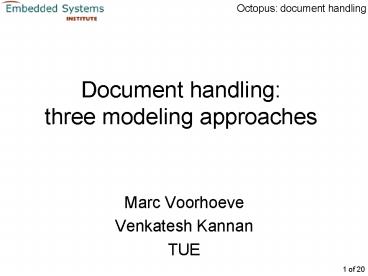Document handling: three modeling approaches - PowerPoint PPT Presentation
1 / 20
Title:
Document handling: three modeling approaches
Description:
Temporal predicates (CTL) can be assessed, e.g. existence of ... Petri net with arc inscriptions, firing conditions. and subnet hierarchy. Eager firing. ... – PowerPoint PPT presentation
Number of Views:20
Avg rating:3.0/5.0
Title: Document handling: three modeling approaches
1
Document handlingthree modeling approaches
- Marc Voorhoeve
- Venkatesh Kannan
- TUE
2
Octopus project
Broker EESI
Industry partner Océ
ResearchersNijmegen
TUE - Electrical EngineeringTUE - Computer
Science
3
Data path concurrent job execution
user
retrieve
store
control
resources
scan
IP1
IP2
Image Processing
4
Engineering decisions - resource capacity -
scheduling rules
Octopus aim Engineering support
Frameworks - TA (Timed Automata) - SDF
(Synchronous Data Flow) - CPN (Colored Petri nets)
State space exploration
Simulation
Approaches
5
Timed automata labeled transition system with
clock variables, that can be set and tested.
states, actions (maybe silent), clock
assignments, clock conditions.
6
Kind of merge with synchronization of clocks.
Temporal predicates (CTL) can be assessed, e.g.
existence of execution path with duration D.
7
CPN (colored Petri nets) Petri net with arc
inscriptions, firing conditions and subnet
hierarchy. Eager firing.
start
x
idle
busy
x
( )
x
x
recover
8
SDF action-based, Petri net subclass (marked
graph)
Firing delays fast optimal schedule computation
9
Special challenge modeling USB
storage/retrieval. unidirectional capacity H,
bidirectional capacity L capacities L,H in
MB/sec satisfying L lt H lt 2L.
Suppose 3H upstream after 1 sec L
downstream timing diagram
10
USB model hybrid system.
Discrete approximation in TA possible. Exact CPN
model by data manipulation. SDF model is still
under construction.
11
Experiences so far - coordination via regular
meetings - agreement on parameters of common
model - mutual validation has been achieved
(despite several difficulties)
Next stages - validation with current project -
exploration of engineering alternatives -
adaptivity?
12
Some difficulties were caused by the
solutions that the various frameworks allow.
CPN tradeoff structure in net vs. color
structure in color opaque high-level flexibility
more structure visual model low-level less
flexible
TA tradeoff model vs. predicate
constraints in model smaller state space more
models
constraints in predicate larger state space less
models (flexibility)
13
Other difficulties caused by unstable
requirements.
CPN model therefore opts for flexibility.
color set JOB sequence of tasks.
14
(No Transcript)
15
parameters
structure of scanner, scanIP, IP1, IP2, printIP
16
structure of USB subnet
17
Depicted USB scenario
time job rate last_update_time trigge
r
0 U H 0 3 1
U L 1 3x D L 1 2 2 U H 2 3 U H 3 3x -
x(H-L)/H
18
Mutual validation do the models match?
TA, SDF find "optimal" schedule within state
space for a given job sequence
CPN nondeterministic eager execution
Mutual validation of models - remove freedom -
model within intersection - compare generated
schedules (traces)
19
Modeling power vs. analysis options CPN most
power, least analyzable. SDF least power,
analysis limited but fast TA wide range of
analysis options danger of state space
explosion
Possible developments for Océ - competition -
cooperation
20
Conclusions Combination of formal
frameworks interesting, but time-consuming. More
time needed for assessment.
Questions?































